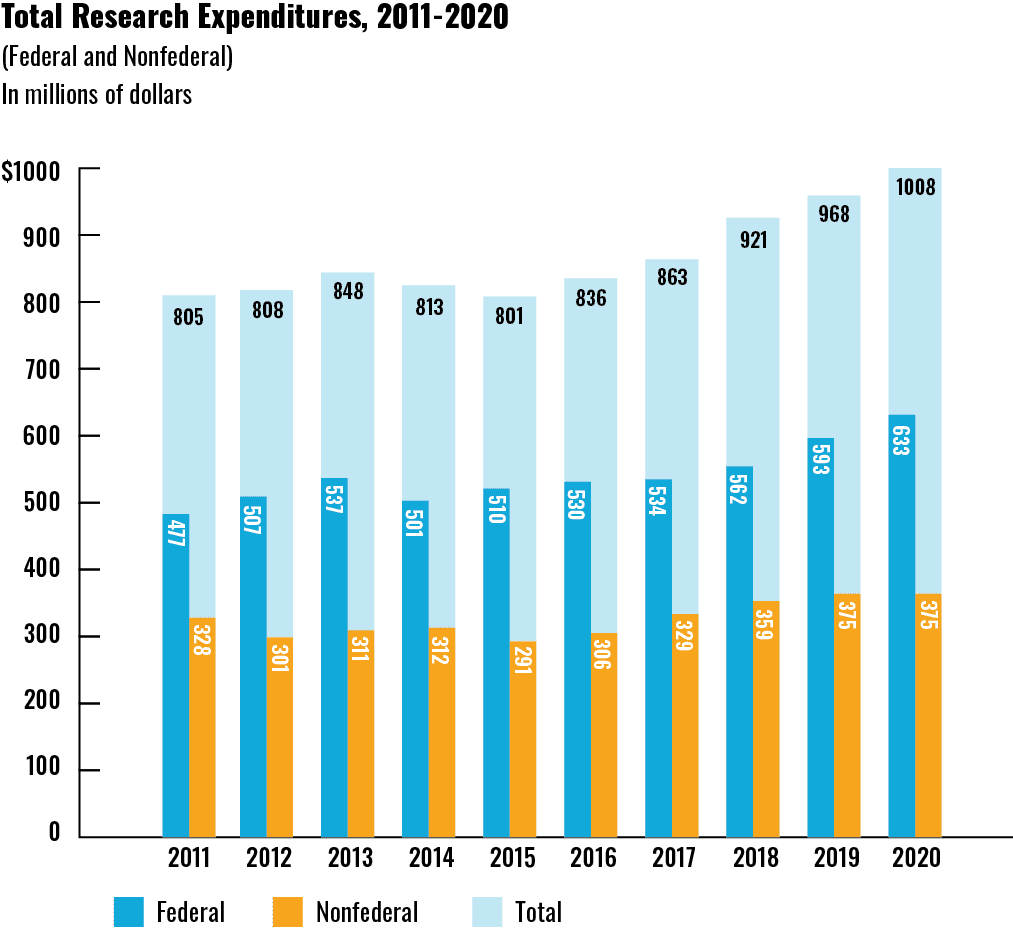The total puts Penn State even higher in elite rankings of national research universities
Penn State’s research expenditures exceeded $1 billion during the 2019-20 fiscal year. The total figure of $1.01 billion reflects the interdisciplinary strength that the university has been building over the past three decades, and puts Penn State even higher in its rankings among fellow research universities.
The breadth of Penn State’s research expertise surpasses that of any university in the country
According to National Science Foundation rankings of Higher Education Research and Development (HERD), Penn State surpasses all other universities in the country in terms of research expenditures by key fields and subfields. It ranks in the top 10 in expenditures in 18 research fields, followed by Johns Hopkins University with 16, and finishing in the top 10.

“This milestone reflects both the strength of external support for the university’s research activity and the broad impact of that activity on solving complex societal problems,” Penn State President Eric Barron said. “From advancing health, to addressing food security and sustainable energy solutions, to contributing to economic development, Penn State’s research enterprise is dedicated to improving the overall quality of life for people in our communities, our nation and our world.”
This year’s total reflects record-breaking federal grants
The total of $1 billion represents a record $633 million in federal funding and $375 million that comes from a combination of private funders, the Commonwealth of Pennsylvania and university sources.
There was a $40 million increase in federal funding over the previous year. The largest single increase came from the Department of Defense, with a grant of $30 million to lead the Interaction of Ionizing Radiation with Matter University Research Alliance, focused on improving current, and developing future, warfighter technology to counter threats of destruction. Another increase was $9 million from the Department of Health and Human Services, with an additional $3.5 million from the Department of Energy.
Research funding from the Commonwealth of Pennsylvania decreased from $73 million to $68 million, but funding from industry, foundations and other sponsors held steady at $101 million.

Research grants help create solutions for DoD, opioid crisis, local waterways
This record-breaking research funding across so many fields of study enables Penn State to continue to work on creating solutions that range from industry innovations to ecological breakthroughs. A $4.9 million grant from the National Institutes of Health is being used for testing a previously approved obesity drug for use in curbing opioid addiction. A $3.5 million grant from the National Science Foundation is being utilized to re-engineer and improve the functionality of Galaxy, a popular scientific data management system that streamlines solutions to complex, multidisciplinary scientific problems. There are non-federally funded projects like the one funded by the Pennsylvania Fish and Boat Commission, that aims to restore the endangered Chesapeake Logperch in the Susquehanna River; a study of noise control in the urban office environment funded by an international supplier of hearing aids; and a grant from the Andrew W. Mellon Foundation to investigate transdisciplinary approaches to the performing arts.
This expenditure total, which represents research undertaken at all Penn State campuses, is even more impressive with the added challenge of this year’s COVID-19-related shutdown. The university worked hard to maintain continuity to its vast research enterprise, even while facilitating a rapid response to the pandemic. “Our continued growth under challenging circumstances demonstrates our resilience and readiness to fulfill our land-grant mission, in Pennsylvania and around the globe,” Senior Vice President for Research Lora Weiss said. “Reaching this milestone speaks to the foresight and sustained hard work of my predecessors over the last three decades. Their vision and careful stewardship built the interdisciplinary culture, which we continue to build upon and innovate in the way we collaborate and do research every day.”

